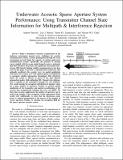Underwater acoustic sparse aperture system performance: Using transmitter channel state information for multipath interference rejection
Author(s)
Puryear, Andrew L.; Chan, Vincent W. S.; Lermusiaux, Pierre F. J.; Burton, Lisa Janelle
DownloadPuryear-2009-Underwater acoustic sparse aperture system performance Using transmitter channel state information for multipath interference rejection.pdf (775.9Kb)
PUBLISHER_POLICY
Publisher Policy
Article is made available in accordance with the publisher's policy and may be subject to US copyright law. Please refer to the publisher's site for terms of use.
Terms of use
Metadata
Show full item recordAbstract
Today's situational awareness requirements in the undersea environment present severe challenges for acoustic communication systems. Acoustic propagation through the ocean environment severely limits the capacity of existing underwater communication systems. Specifically, the presence of internal waves coupled with the ocean sound channel creates a stochastic field that introduces deep fades and significant intersymbol interference (ISI) thereby limiting reliable communication to low data rates. In this paper we present a communication architecture that optimally predistorts the acoustic wave via spatial modulation and detects the acoustic wave with optimal spatial recombination to maximize reliable information throughput. This effectively allows the system to allocate its power to the most efficient propagation modes while mitigating ISI. Channel state information is available to the transmitter through low rate feedback. New results include the asymptotic distribution of singular values for a large number of apertures. Further, we present spatial modulation at the transmitter and spatial recombination at the receiver that asymptotically minimize bit error rate (BER). We show that, in many applications, the number of apertures can be made large enough so that asymptotic results approximate finite results well. Additionally, we show that the interference noise power is reduced proportional to the inverse of the number of receive apertures. Finally, we calculate the asymptotic BER for the sparse aperture acoustic system.
Date issued
2009-10Department
Massachusetts Institute of Technology. Department of Electrical Engineering and Computer Science; Massachusetts Institute of Technology. Department of Mechanical EngineeringJournal
OCEANS 2009-EUROPE, 2009. OCEANS '09.
Publisher
Institute of Electrical and Electronics Engineers
Citation
Puryear, A. et al. “Underwater acoustic sparse aperture system performance: Using transmitter channel state information for multipath & interference rejection.” OCEANS 2009-EUROPE, 2009. OCEANS '09. 2009. 1-9. ©2009 Institute of Electrical and Electronics Engineers.
Version: Final published version
Other identifiers
INSPEC Accession Number: 10914946
ISBN
978-1-4244-2522-8